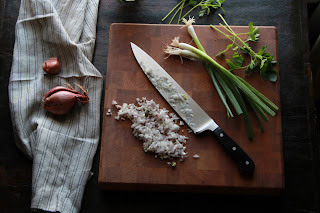So, this recipe ends up working for me, and I think the flavors are quite nice.
You'll get some freshness from the lemon and parsley. The cooked shallot adds one type of allium note, while the more raw green onion adds a greener, more delicate tone.
Sure, I bet you could use canned salmon if you like, and reduce the steps and time a bit. But most of the time I prefer to do things ALL the way myself- in some ways it can be a skill and practice thing, and in others it's the fact that I know as much as possible about how things are accomplished and cooked- and that's why I start from as scratch as possible. Plus, I have the idea that your salmon cakes will be a bit more tender when you start with raw salmon. Then again, I can't say I've tried it with canned salmon.
If you're cooking salmon anyway, great. Maybe make a little extra and extend that meal a bit into salmon cakes the next day.
And if you'll just be cooking the salmon to flake for salmon cakes, know that the cut doesn't have to be the center- the initial shape certainly won't be there for presentation.
The nice thing is that it's not much extra work to double the recipe, and really, the cakes don't take awfully long to cook. And perhaps to speed the process (if you can handle it for a larger batch), you could have two pans going at once.
The type of salmon is up to you. For example, Sockeye, King, and Coho vary among themselves, but would all have a stonger flavor and deeper color than the more neutral Keta salmon (Sockeye is especially red). Strength of flavor, oil content, and color of salmon vary. All salmon are not the same. If you have a choice and are unsure, talk to the fishmonger before making a decision and then go with what you like.
If I'm making a larger batch, I prefer mix a couple different types to keep things interesting.
I like to serve these with greens alongside, with lemon wedges and sriracha (*please note the ever-important life skill of writing with condiments), though the "unadorned" version certainly works, too.
Salmon Cakes
makes 5
1 lb. (500 g will work) fresh salmon
1/2 c (55 g) shallot, minced
1 T (15 ml) olive oil, plus extra if needed
zest of 1/2 lemon
3 green onions, 4 if small, thinly sliced
2 T (7 g) fresh minced parsley
2 large eggs, lightly beaten
1/2 c (50 g- though weight may vary by type/brand) breadcrumbs (gluten free if preferred)
salt
pepper
To cook the salmon cakes:
1 T (14 g) butter
1 T (15 ml) olive oil
Cook the salmon: Preheat the oven to 350 F (180 C) Place the salmon skin side down on a foil covered pan and season it with salt and pepper. Drizzle with a bit of olive oil.
Bake the salmon 20 minutes, remove the pan from the oven and let the salmon rest 10 minutes. Cover the pan with foil and refrigerate the salmon until cold- at least 30 minutes.
Meanwhile saute the shallots in a pan with the tablespoon of olive oil, just until translucent. Remove from the heat and let cool.
Flake the salmon into a large bowl. Add the cooked and cooled shallot, lemon zest, green onion, parsley, eggs, breadcrumbs, and 1 t (5 g) salt and 1/2 t (1.3 g on a sensitive scale- or add to taste) freshly ground black pepper. Mix gently until everything is fully incorporated, cover, and refrigerate 1 hour (the chilled/rested mixture is easier to form).
At this point you can divide the salmon mixture into 5 portions (a generous 1/2 cup each) and shape into cakes. Place on a tray, cover, and refrigerate if not cooking immediately.
Heat a heavy frying pan over medium heat. Add the butter and olive oil. When melted, swirl the pan to distribute evenly. Depending on your pan size and comfort level, carefully add the salmon cakes one at a time, cooking 2 or 3 to begin with (or all 5). Cook about 4 minutes on each side or until deep golden brown.
Keep the cooked salmon cakes warm on a paper towel lined sheetpan in a 250 F (120 C) oven- especially important if you're doubling the recipe.
(And if doubling, you will likely want to remove the oil/butter mixture from the pan and replenish it after a round or two of cooking)













No comments:
Post a Comment